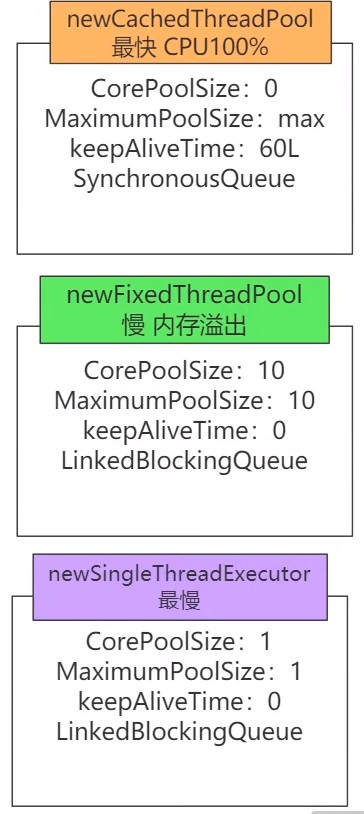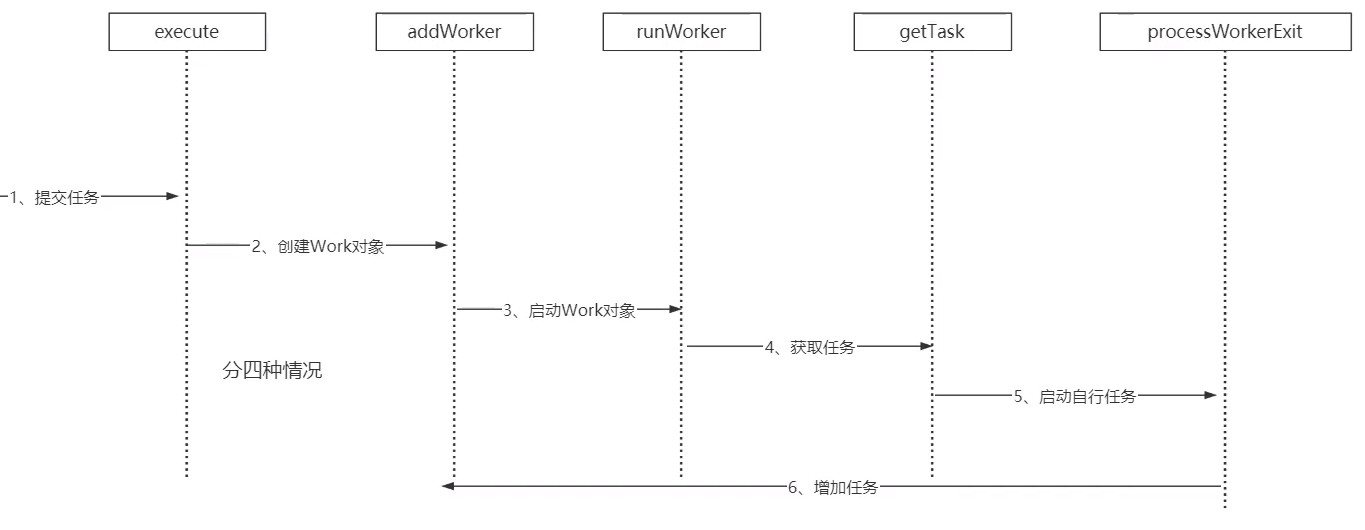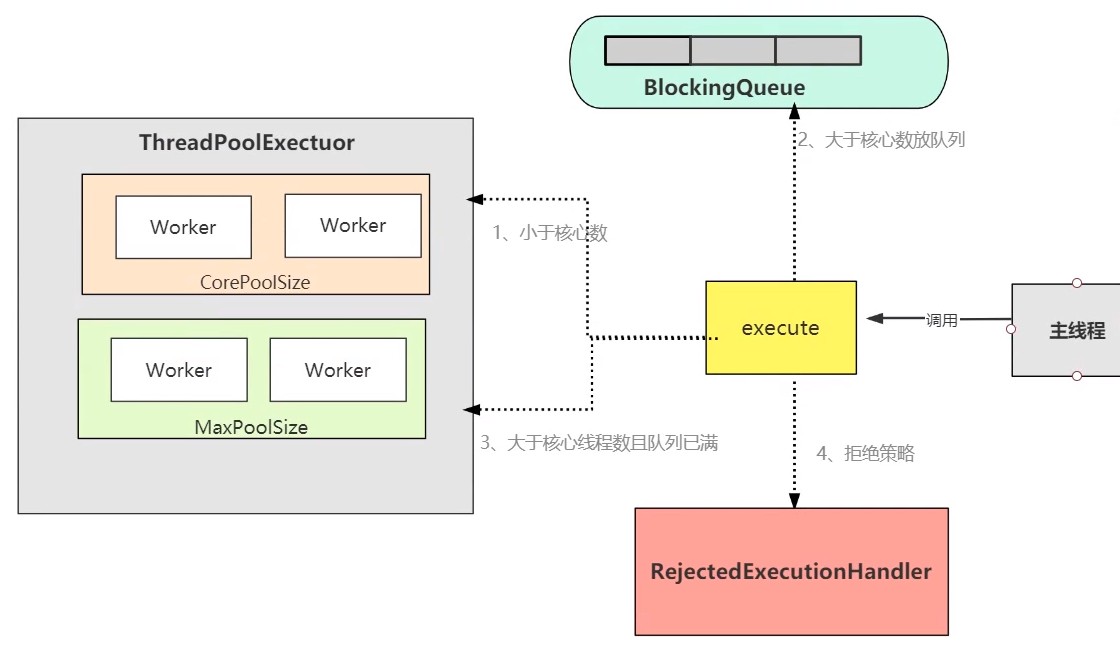线程池参数
public ThreadPoolExecutor(int corePoolSize,
int maximumPoolSize,
long keepAliveTime,
TimeUnit unit,
BlockingQueue<Runnable> workQueue,
ThreadFactory threadFactory) {
this(corePoolSize, maximumPoolSize, keepAliveTime, unit, workQueue,
threadFactory, defaultHandler);
}//核心线程数,最大线程数,超时等待时间,超时等待单位,阻塞队列,线程工厂,拒绝策略

提交优先级:core thread > queue > other thread
执行优先级:core thread > other thread > queue
execute方法
ThreadPoolExecutor有一个AtomicInteger变量,叫ctl(control的简写),一共32位,
高3位为线程池的状态runstatus(Running,Shutdown,Stop,Tidying,Terminate),
低29位存当前有效线程数workerCount

private final AtomicInteger ctl = new AtomicInteger(ctlOf(RUNNING, 0));
private static final int COUNT_BITS = Integer.SIZE - 3;//COUNT_BITS=29
private static final int CAPACITY = (1 << COUNT_BITS) - 1;//线程容量
// runState is stored in the high-order bits
private static final int RUNNING = -1 << COUNT_BITS;//111
private static final int SHUTDOWN = 0 << COUNT_BITS;//000
private static final int STOP = 1 << COUNT_BITS;//001
private static final int TIDYING = 2 << COUNT_BITS;//010
private static final int TERMINATED = 3 << COUNT_BITS;//011
//返回状态,上边那5种之一
private static int runStateOf(int c) { return c & ~CAPACITY; }
//返回工作线程数
private static int workerCountOf(int c) { return c & CAPACITY; }
private static int ctlOf(int rs, int wc) { return rs | wc; }
public void execute(Runnable command) {
if (command == null)
throw new NullPointerException();
int c = ctl.get();
//判断工作线程数小于核心线程数
if (workerCountOf(c) < corePoolSize) {
//执行addworker,创建一个核心线程,创建失败重新获取ctl
if (addWorker(command, true))
return;
c = ctl.get();
}
//如果工作线程数大于核心线程数,判断线程池的状态是否为running,并且可以添加进队列
//如果线程池不是running状态,则执行拒绝策略,(还是会调用一次addworker)
if (isRunning(c) && workQueue.offer(command)) {
//再次获取ctl,进行双重检索
int recheck = ctl.get();
//如果线程池是不是处于RUNNING的状态,那么就会将任务从队列中移除,
//如果移除失败,则会判断工作线程是否为0 ,如果过为0 就创建一个非核心线程
//如果移除成功,就执行拒绝策略,因为线程池已经不可用了;
if (! isRunning(recheck) && remove(command))
reject(command);
else if (workerCountOf(recheck) == 0)
addWorker(null, false);
}
//线程池挂了或者大于最大线程数
else if (!addWorker(command, false))
reject(command);
}addWorker方法
其实做了两件事:
- 才用循环CAS操作来将线程数加1;
- 新建一个线程并启用。
private boolean addWorker(Runnable firstTask, boolean core) {
//(1)循环CAS操作,将线程池中的线程数+1.
retry:
for (;;) {
int c = ctl.get();
int rs = runStateOf(c);
// Check if queue empty only if necessary.
if (rs >= SHUTDOWN &&
! (rs == SHUTDOWN &&
firstTask == null &&
! workQueue.isEmpty()))
return false;
for (;;) {
int wc = workerCountOf(c);
//core true代表是往核心线程池中增加线程 false代表往最大线程池中增加线程
//线程数超标,不能再添加了,直接返回
if (wc >= CAPACITY ||
wc >= (core ? corePoolSize : maximumPoolSize))
return false;
//CAS修改ctl的值+1,在线程池中为将要添加的线程流出空间,成功退出cas循环,失败继续
if (compareAndIncrementWorkerCount(c))
break retry;
c = ctl.get(); // Re-read ctl
//如果线程池的状态发生了变化回到retry外层循环
if (runStateOf(c) != rs)
continue retry;
}
}
//(2)新建线程,并加入到线程池workers中。
boolean workerStarted = false;
boolean workerAdded = false;
Worker w = null;
try {
//对workers操作要通过加锁来实现
final ReentrantLock mainLock = this.mainLock;
w = new Worker(firstTask);
final Thread t = w.thread;
if (t != null) {
//细化锁的力度,防止临界区过大,浪费时间
mainLock.lock();
try {
// Recheck while holding lock.
// Back out on ThreadFactory failure or if
// shut down before lock acquired.
int c = ctl.get();
int rs = runStateOf(c);
//判断线程池的状态
if (rs < SHUTDOWN ||
(rs == SHUTDOWN && firstTask == null)) {
//判断添加的任务状态,如果已经开始丢出异常
if (t.isAlive()) // precheck that t is startable
throw new IllegalThreadStateException();
//将新建的线程加入到线程池中
workers.add(w);
int s = workers.size();
//修正largestPoolSize的值
if (s > largestPoolSize)
largestPoolSize = s;
workerAdded = true;
}
} finally {
mainLock.unlock();
}
//线程添加线程池成功,则开启新创建的线程
if (workerAdded) {
t.start();//(3)
workerStarted = true;
}
}
} finally {
//线程添加线程池失败或者线程start失败,则需要调用addWorkerFailed函数,
//如果添加成功则需要移除,并回复clt的值
if (! workerStarted)
addWorkerFailed(w);
}
return workerStarted;
}
Worker类继承自AQS,实现了Runnable接口。
private final class Worker
extends AbstractQueuedSynchronizer
implements Runnable
{
private static final long serialVersionUID = 6138294804551838833L;
//线程池中正真运行的线程。通过我们指定的线程工厂创建而来
final Thread thread;
//线程包装的任务。thread 在run时主要调用了该任务的run方法
Runnable firstTask;
//记录当前线程完成的任务数
volatile long completedTasks;
Worker(Runnable firstTask) {
setState(-1); // inhibit interrupts until runWorker
this.firstTask = firstTask;
//利用我们指定的线程工厂创建一个线程
this.thread = getThreadFactory().newThread(this);
}
public void run() {
runWorker(this);
}参考:https://blog.csdn.net/varyall/article/details/82392048
runWorker方法
从中可以看出workQueue的优先级是最低的。
final void runWorker(Worker w) {
Thread wt = Thread.currentThread();
Runnable task = w.firstTask;
w.firstTask = null;
w.unlock(); // allow interrupts
boolean completedAbruptly = true;
try {
//task = getTask()中workQueue.poll,所有队列执行的优先级是最低的
while (task != null || (task = getTask()) != null) {
w.lock();
//线程池处于stop状态或者当前线程被中断时,线程池状态是stop状态。
//但是当前线程没有中断,则发出中断请求
if ((runStateAtLeast(ctl.get(), STOP) ||
(Thread.interrupted() &&
runStateAtLeast(ctl.get(), STOP))) &&
!wt.isInterrupted()) {
wt.interrupt();
}
try {
//开始执行任务前的Hook,类似回调函数
beforeExecute(wt, task);
Throwable thrown = null;
try {
//执行任务
task.run();
} catch (RuntimeException x) {
thrown = x; throw x;
} catch (Error x) {
thrown = x; throw x;
} catch (Throwable x) {
thrown = x; throw new Error(x);
} finally {
//任务执行后的Hook,类似回调函数
afterExecute(task, thrown);
}
} finally {
//执行完毕后task重置,completedTasks计数器++,解锁
task = null;
w.completedTasks++;
w.unlock();
}
}
completedAbruptly = false;
} finally {
//线程空闲达到我们设定的值时,Worker退出销毁。
processWorkerExit(w, completedAbruptly);
}
}回收线程方法
private void processWorkerExit(Worker w, boolean completedAbruptly) {
if (completedAbruptly) // If abrupt, then workerCount wasn't adjusted
//如果是意外退出的话,那么就需要把WorkerCount--
decrementWorkerCount();
final ReentrantLock mainLock = this.mainLock;
mainLock.lock();
try {
completedTaskCount += w.completedTasks;
//Worker移除
workers.remove(w);
} finally {
mainLock.unlock();
}
//判断当前的线程池是否处于SHUTDOWN状态,判断是否要终止线程
tryTerminate();
int c = ctl.get();
//如果当前线程池状态比STOP大的话,就不处理
if (runStateLessThan(c, STOP)) {
if (!completedAbruptly) {
//allowCoreThreadTimeOut=true的话,核心线程超时也会被销毁
int min = allowCoreThreadTimeOut ? 0 : corePoolSize;
//Queue不为空的话至少留一个
if (min == 0 && ! workQueue.isEmpty())
min = 1;
//当前线程大于最小的话直接返回
if (workerCountOf(c) >= min)
return; // replacement not needed
}
//如果当前运行的Worker数比当前所需要的Worker数少的话,调用addWorker
addWorker(null, false);
}
}

